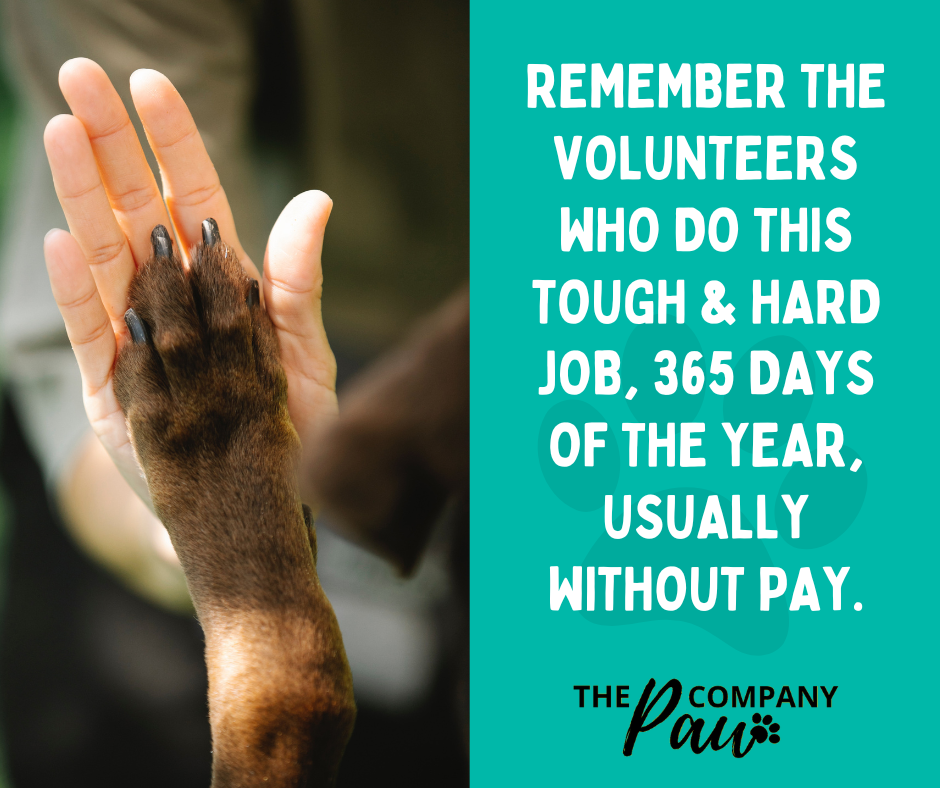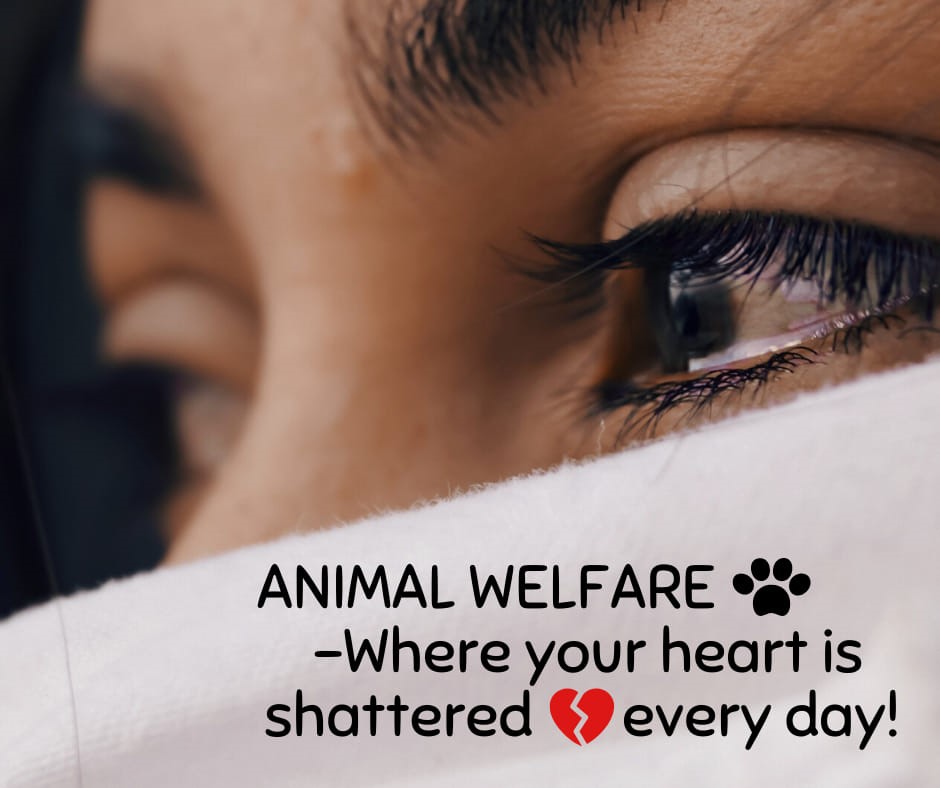
UNRAVELING COMPASSION FATIGUE’S IMPACT ON ANIMAL WELFARE WORKERS.
With the cold of winter in full swing as well as tough economic times, the animal shelters are full and the animal rescuers are tired. I am willing to bet that most rescuers are one failed rescue away from quitting. For that reason I want to reshare an important topic which I wrote about a year ago.
Compassion fatigue is a well-known phenomenon that affects individuals in caregiving professions, and one group particularly susceptible to this condition is animal welfare workers. These dedicated individuals play a crucial role in providing care, protection, and support to animals in need. However, the nature of their work often exposes them to the distressing realities of animal abuse, neglect, and suffering, making them vulnerable to the emotional toll of compassion fatigue.
In this article, we will unravel the concept of compassion fatigue and its impact on animal welfare works as well as strategies to prevent and manage this condition. By understanding the complexities of compassion fatigue within the context of animal welfare work, we can better support these compassionate individuals and ensure the continued well-being and care of the animals they tirelessly advocate for.
To understand the fatigue of compassion, we first have to look at what compassion is.
Compassion is a profound and empathetic understanding of the suffering or distress experienced by others, coupled with a genuine desire to alleviate or lessen their pain. It is a fundamental human emotion and virtue that involves being sensitive to the needs, feelings, and circumstances of others, even if they are different from one’s own. Compassion is characterized by a deep sense of caring, kindness, and a willingness to act to help and support others, often driven by a sense of moral responsibility. Compassion is an essential aspect of building and maintaining healthy relationships, fostering a sense of community, and promoting social cohesion. It is not limited to familial or close relationships but extends to strangers and even beyond species boundaries, as seen in the case of animal welfare and environmental conservation.
WHAT IS COMPASSION FATIGUE?
Compassion fatigue is a state of physical, emotional, and mental exhaustion that can occur in individuals, particularly caregivers or professionals, who regularly provide care and support to others, often in demanding or traumatic situations. It is characterized by increased feelings of emotional distress and a reduced ability to cope with the suffering or trauma of others.
Compassion fatigue can arise from consistently witnessing and empathizing with the pain, trauma, or distress experienced by others, leading to a diminished capacity to provide care and support effectively. It can impact both personal well-being and professional performance, causing symptoms such as emotional detachment, cynicism, irritability, physical exhaustion, and a sense of overwhelming burden. Recognizing and addressing compassion fatigue is crucial in preventing burnout and maintaining the well-being of individuals engaged in caregiving or helping professions.
Compassion fatigue, trauma, and burnout are related concepts but have distinct differences: In summary, compassion fatigue is a specific form of exhaustion that arises from providing care, trauma refers to distressing events or experiences that overwhelm a person’s coping mechanisms, and burnout is a state of chronic exhaustion and detachment often related to work-related stress. Although they can overlap and interact, each concept captures a unique aspect of the challenges individuals may face in caregiving or demanding professions.
Compassion fatigue can affect individuals in various caregiving or helping professions, particularly those who are regularly exposed to the suffering, trauma, or emotional challenges of others. The following are some professions that are more prone to experiencing compassion fatigue:
- Healthcare Workers
- Mental Health Professionals
- First Responders
- Animal Welfare Workers
- Teachers and Educators
- Caregivers and Social Service Workers
It’s important to note that while these professions are more commonly associated with compassion fatigue, anyone who regularly provides care, support, or assistance to others can be at risk. Understanding the signs of compassion fatigue and implementing self-care strategies is crucial for individuals in these professions to maintain their own well-being and continue providing effective care to those in need.

Editorial note: This article is a reprint from 26 July 2023.
Also, read about how giving animals away for free make rescuer’s work even harder.
ANIMAL WELFARE WORKERS AND COMPASSION FATIGUE
Animal welfare workers are particularly susceptible to compassion fatigue due to several factors inherent in their work. Undoubtedly, animal welfare is one of the most challenging tasks to undertake. It extends far beyond conventional 8-5 working hours and exacts a toll both physically and emotionally. In this industry, the victims cannot speak for themselves, and for most in society, their lives are not seen as of “equal value” compared to humans, although our courts, since 2016 recognized them as sentient beings in a landmark case. This makes the work hard on a different level. Volunteers (most don’t get paid) who commit to animal welfare find themselves confronted with heart-wrenching moments almost every day, causing them to contemplate giving up on numerous occasions
While the primary focus of your local shelter is to facilitate the adoption of hopeful animals into loving homes, their responsibilities go well beyond that. Operating tirelessly 365 days a year, the shelter takes in homeless animals, providing them with necessities such as food, water, and shelter. Moreover, they actively engage in rescuing injured or abused animals and making efforts to reunite lost pets with their families. This ongoing dedication ensures that the shelter remains steadfast in its mission to save and protect animals in need.
Here are some reasons why they may experience compassion fatigue:
- Continuous Exposure to Animal Suffering: Animal welfare workers are consistently exposed to the distressing realities of animal abuse, neglect, and suffering. Witnessing animals in pain or facing life-threatening situations can be emotionally draining and take a toll on their well-being.
- Empathy and Emotional Investment: Animal welfare workers often develop strong emotional connections with the animals they care for. They invest their time, energy, and compassion into improving the lives of these animals, making it harder to detach emotionally from their experiences.
- Limited Resources and Overwhelming Workload: Animal welfare organizations often operate with limited resources, which can result in high workloads and increased stress levels for workers. The pressure to rescue, rehabilitate, and find suitable homes for animals within tight deadlines can be overwhelming.
- Secondary Traumatic Stress: Witnessing and hearing about the traumatic experiences of animals can lead to secondary traumatic stress. The constant exposure to stories of animal cruelty and suffering can trigger feelings of helplessness, sadness, frustration, guilt, and anger, further contributing to compassion fatigue. It is not only one sort of emotion you experience.
- Challenging Work Environments: Animal welfare workers may encounter various challenges in their work environments, such as limited support, organizational constraints, dealing with difficult or uncooperative individuals, or facing criticism from the public. These factors can add to the stress and emotional strain they experience.
- Personal Investment and High Expectations: Many individuals drawn to animal welfare work have a deep personal investment in the cause. They often hold themselves to high standards, wanting to make a significant difference in the lives of animals. This personal investment and the weight of expectations can contribute to increased stress and pressure.
- Lack of Recognition and Acknowledgment: Animal welfare work can be emotionally demanding and often goes unnoticed or undervalued by society. None of us that are in it for the right reason, do it for recognition, but all people appreciate recognition. The lack of recognition and acknowledgment for the important work they do can lead to feelings of frustration and burnout.
- Life and Death Decisions in Their Hands: These individuals almost daily deal with death as well as making death decisions by opting to euthanize an animal for example. It is not only the sick or injured that have to die, but because of the massive overpopulation crisis we face, in SA daily, at least 2800 (yes two zeros) healthy animals have to be humanely killed. Having to make such a decision by putting a healthy animal on the list for today, is gut-wrenching in itself.
It’s important to acknowledge and address the unique challenges that animal welfare workers face to ensure their well-being and sustainability in their important roles.

DEALING WITH COMPASSION FATIGUE
Dealing with compassion fatigue is crucial for animal welfare workers to maintain their well-being and continue providing effective care to animals in need. Here are some strategies to help cope with compassion fatigue in the context of animal welfare:
Self-Care: Prioritize self-care activities that promote physical, emotional, and mental well-being. This can include engaging in hobbies, exercising regularly, practicing relaxation techniques, getting enough sleep, and maintaining a healthy lifestyle. Taking care of oneself allows for better resilience and the ability to handle the emotional demands of the work.
Boundaries and Time Management: Establish clear boundaries between work and personal life. Set realistic expectations and avoid overextending oneself. Effective time management can help reduce stress and prevent burnout. Ensure adequate breaks, rest, and time for relaxation and rejuvenation.
Support Networks: Connect with others who share similar experiences, either within the organization or through external support groups. Peer support can provide validation, understanding, and a space to share emotions and experiences. Seek out counseling or therapy services specifically designed for animal welfare workers if needed. Find coping strategies that work for you as an individual.
Education and Training: Continuously seek opportunities for education and training to enhance skills and knowledge in animal welfare. This can help build confidence, improve decision-making, and increase job satisfaction. Staying updated on current best practices and advancements in the field can reduce feelings of helplessness and increase effectiveness.
Mindfulness and Stress Reduction: Practice mindfulness techniques, such as meditation or deep breathing exercises, to reduce stress and promote emotional well-being. Mindfulness helps bring focus to the present moment, reducing anxiety about the past or future. Incorporate stress reduction techniques into daily routines to manage stress levels effectively.
Seek Supervision and Consultation: Consult with supervisors or mentors within the organization to discuss challenging cases, seek guidance, and process emotions. Supervision can provide an opportunity to debrief and gain support from experienced professionals. Consultation with experts in the field can offer fresh perspectives and advice on complex situations.
Take Breaks and Vacations: Allow yourself regular breaks and take vacation time to rest and recharge. Time away from work, even if it’s just a short break, can help gain perspective and prevent burnout. Ensure adequate coverage or support during absences to reduce concerns about work responsibilities. We have to accept the reality that we can’t save them all. People breed and hurt animals faster than we can rescue. We are working on ultimate solutions and I will never stop, but for now, we have to accept this sad reality.
Inspector debriefs and rotation: A big problem in organizations with inspectors (apart from the lack of proper and enough inspectors) is that they have to deal with tough stuff alone. It is the responsibility of their team managers and organization’s leaders to make sure these individuals get debriefed regularly and get rotational breaks (if they have more than one inspector) or at least some sort of break apart from regular leave.
Remember, self-care and recognizing the signs of compassion fatigue are essential in maintaining overall well-being and providing effective care for animals.
SUICIDES IN ANIMAL WELFARE
Research on suicide rates specifically among animal welfare workers is limited, and it is challenging to determine the exact prevalence or rates of suicide within this particular industry. However, it is important to acknowledge that the field of animal welfare can be emotionally and physically demanding, and individuals working in this sector may face stress, burnout, and mental health challenges often. Those in animal welfare know it is high and many have likely thought about doing it. Some studies have indicated higher rates of mental health issues, such as depression, anxiety, and compassion fatigue, among individuals in caregiving roles, including animal welfare workers. These factors, combined with the emotional toll of working with animals in distressing situations, could potentially contribute to an increased risk of mental health challenges and, in some cases, suicide.
It is crucial to prioritize mental health support and resources for animal welfare workers, as well as promote awareness, education, and destigmatization of mental health issues within the industry. Providing access to counselling services, implementing mental health training, and fostering a supportive work environment can help mitigate the risk and promote well-being among animal welfare workers.

WHAT CAN YOU DO TO HELP?
If someone close to you is suffering from compassion fatigue, there are several ways you can support and help them:
- Be a Listening Ear
- Encourage Self-Care
- Provide Practical Support to help lighten their load
- Validate Their Emotions
- Encourage Boundaries
- Offer Resources
- Be Patient and Understanding
Remember, supporting someone with compassion fatigue requires empathy, patience, and active listening. By offering a compassionate and supportive presence, you can provide valuable assistance to your loved one during their healing process. There are many ways for the public to lighten the load for animal welfare warriors.
In the world of animal welfare, compassion fatigue poses a significant challenge for those dedicated to caring for animals in need. The emotional demands, witnessing suffering and neglect, and advocating tirelessly for animals can take a toll on the well-being of animal welfare workers. Recognizing the signs of compassion fatigue, implementing self-care strategies, seeking support, and maintaining healthy boundaries are vital in preventing and managing this condition. By addressing compassion fatigue in the context of animal welfare, we can ensure the well-being of those who tirelessly advocate for animals, allowing them to continue making a positive difference in the lives of our furry companions. Together, we can support and empower these compassionate individuals to create a brighter future for animals in need.
Next week we will look at the factors contributing to the behaviour of your pets.